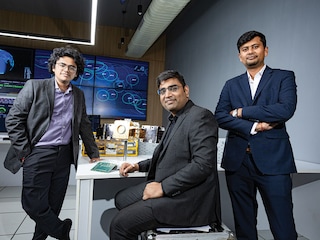How GalaxEye's Mission Drishti can shore up defence and agriculture
The spacetech startup is building a satellite to capture high-resolution, all-weather images of Earth


In a lab in Bengaluru, a group of engineers at GalaxEye is building Mission Drishti—a satellite designed to change how the world sees Earth. Slated for launch early next year, Drishti will be the, “…the biggest satellite launched by a private company in India”, says Kishan Thakkar, vice president-engineering.
Weighing 160 kg, the satellite can capture the Earth’s surface using two sensors—Synthetic Aperture Radar (SAR) and multispectral optical imager (MSI)s—mounted on the same platform. While SAR sensors can penetrate clouds and smoke, optical sensors will be able to offer intuitive, colour-rich visuals. By fusing both simultaneously, this technology, also known as sync-fused opto-SAR imaging, will allow the satellite to produce all-weather, day-and-night detailed images regardless of cloud cover or lighting conditions, something traditional optical satellites can’t achieve.
Formally incorporated in May 2021 after a year in stealth mode, GalaxEye was founded by five IIT-Madras graduates—Suyash Singh, chief executive officer; Rakshit Bhatt, vice president-product; Pranit Mehta, vice president-sales operations; and Denil Chawda, chief technology officer, along with Thakkar.
Inspired by their Hyperloop work, they explored using electrical propulsion to launch satellites into space. “But we realised it would need massive infrastructure, such as a 40-kilometer launch tube at a steep angle, which was not feasible,” says Chawda.
Then came the idea for GalaxEye, born from a real-world challenge. While working on a consulting project in the US, Singh had to assess wildfire damage in California using satellite data. While optical images were obscured by smoke, SAR images were difficult to interpret. “It took months just to understand what the SAR image meant,” says Chawda.
That experience revealed a crucial need for the fusion of the two to be able to produce weather-independent and detailed imagery.
The applications for Drishti are wide-ranging, Chawda says. Defence is a key customer, particularly because operations and strikes occur at night, when quick and reliable imaging is critical. But beyond that, GalaxEye is also exploring commercial use cases, for instance, in agriculture to help farmers during monsoon, insurance agencies for rapid damage assessment, or even aquaculture to help companies trace shrimp cultivation sites through satellite imagery.
“The work on the satellite began in early 2023,” says Thakkar. “It’s been a three-year journey of experimentation, testing, and precision engineering. We recently completed one round of testing at URSC, Bengaluru, and another begins next week,” he adds.
Also Read: The future of space careers: Roles in business, policy, and leadership
While Drishti marks the beginning, GalaxEye’s larger vision is to launch a constellation of 10 satellites that will deliver high-resolution data.
As the mission nears the launch, the founders recall how building this engineering feat came with its own set of challenges.
“One of the questions we faced early on was whether a startup like ours could really pull off something this complex,” recalls Thakkar.
Traditionally, organisations such as the Indian Space Research Organisation (ISRO) and Defence Research and Development Organisation (DRDO) design satellites of this scale. Therefore, for a young and private company, attempting something of this magnitude meant not only navigating scepticism but also resource constraints and technological difficulties.
“Each payload—optical and synthetic aperture radar—was challenging enough on its own,” Thakkar says. “Integrating both into one compact, reliable system was something no one had achieved before.” Payloads refer to the equipment carried by a rocket or spacecraft that is crucial to the mission’s objectives, in this case, the two sensors (SAR and MSI).
The team began testing on drones and aerial platforms before qualifying their payloads for space under ISRO’s Poem-4 mission in 2023. The mission offers an opportunity to test payloads on ISRO’s rockets for scientific and technological experiments. “Many companies struggled to survive those conditions, but our payloads passed every test,” says Thakkar.
Additionally, as erratic weather becomes a global concern, “During floods, storms, or landslides, ground systems fail. Our hybrid satellite will be able to see through clouds and darkness to provide real-time insights for governments, insurers, and climate researchers,” says Thakkar.
Chawda attributes the success to their 100-member team of engineers, many from IITs, ISRO, and batchmates and acquaintances they called back from other countries.
So far, GalaxEye has filed six patents to safeguard its intellectual property. These range from novel image and signal processing methods to those for hardware. “However, our first and most significant patent was for the fusion concept itself,” Thakkar adds.
In the journey, GalaxEye has raised $14.5 million from Speciale Invest, Rainmatter, Mela Ventures, and Infosys.
“Their ability to integrate multi-sensor imaging into a single satellite is not just a technological leap but a reflection of India’s deep-science innovation coming of age,” says Vishesh Rajaram, managing partner, Speciale Invest.
Viju George, partner, Mela Ventures, adds, “GalaxEye is more than a satellite company. It has unparallelled ability to process and interpret fused data images, offering invaluable strategic insights to the defence forces. We also see clear potential to develop non-defence revenue streams over the medium-to-long term.”With this capital primarily gone into R&D and building Drishti, the next phase will focus on scaling up constellations.
Looking ahead, the founders believe spacetech and deeptech in India have already come a long way. “The difference now is that private companies are building full systems, not just components. That helps bigger organisations like NASA, ISRO to focus on advanced research while private players scale technology for the market,” says Chawda.
First Published: Oct 24, 2025, 12:53
Subscribe Now